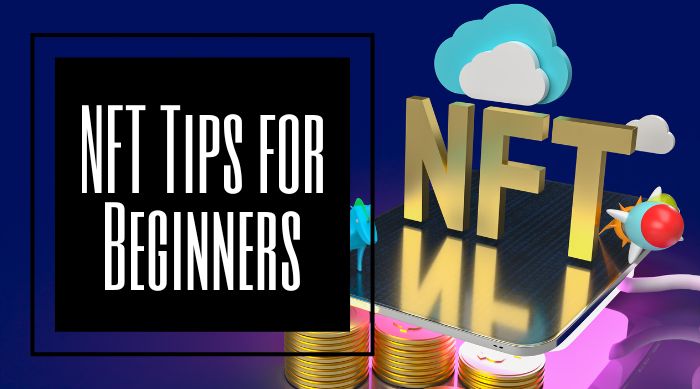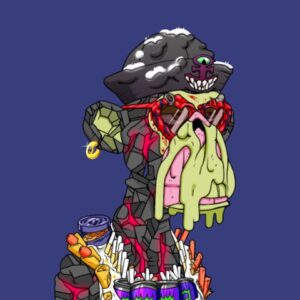What does a new NFT collector need to know about investing in NFTs? Our NFT tips for beginners include some of the most obvious advice; know your seller, fees, and terms. But this advice addresses those issues as they relate to some not-so-obvious pitfalls to avoid while learning about NFTs for beginners.

NFT Tips for Beginners
Here’s a bit of advice you won’t read on other crypto blogs. Decide in advance why you want to purchase the NFTs you’re looking at. Is this an investment? Do you really like the art, the artist, and the project? Or is there another reason?
For example, if you want exclusive access to more NFTs in the form of members-only access, or you want IRL access to crypto-based limited events? Some NFT projects promise all this and more.
Why is your intent so important? Because it helps you set boundaries. For example, if you are an art collector and you simply want to collect this new up-and-coming type of artwork, your price point may be dictated by how “up there” you want to go.
Do you want an original artwork by Beeple? Do you care less about NFT artwork that isn’t making headlines? Your price range may be higher than someone who simply likes the artwork they see and doesn’t care about the personalities behind it. This is an important issue to contemplate before thinking about the other areas below.
NFT Tips For Beginner: Know Your Gas Fees
Gas fees are typical costs for doing business buying and selling crypto and NFTs. “Gas” refers to how much energy it may cost to process your transaction and the fees associated with that energy.
Like real-world gasoline prices, NFT gas fees are subject to change due to overall demand, the demand during peak use or “rush hour” time frames, the type of blockchain you are using, etc.
Knowing when gas fees are likely to be elevated (peak use times, for example) can play an important part in how you do business on the blockchain. Do you need to minimize your upfront costs as much as possible?
You’ll want to look for NFTs on blockchains with lower gas fees or those on Bitcoin or Ethereum but at off-peak times. Gas fees can add up–it’s crucial to know all the associated fees with your transaction and how they will affect the final price of the artwork you buy.
The good news is that when you research the gas fees on the blockchain of your choice, you will also learn when typical off-peak hours are.
Ethereum, for example, has an off peak window between 9PM and 11PM UTC (coordinated universal time). It’s easy for some to forget that crypto is a global phenomenon; don’t expect all terms and conditions to reflect North American money, time zones, laws, etc.
Some sources advise caution when converting one type of cryptocurrency into another so you can buy NFTs on different blockchains. You should learn what the total cost of that conversion is compared to the gas fees and other expenses associated with buying an NFT on a different blockchain. Will you spend more than if you didn’t convert the crypto from one type to another?
NFT Tips: Check The Floor Price And Volume
How many NFTs in a project were minted? How many are in circulation and what is the lowest price you can pay for one? These factors are important because new NFT collectors might forget to check beyond the secondary market.
If an initial run of 10,000 NFTs only has 5,000 of those in circulation, are they still available direct from the source instead of the secondary market? If so, the price point could be different. It may not be, but who reading this would feel good about paying more for an NFT on the secondary market when they could have gotten it from the source?
Remember, when checking the volume of an NFT project, some number of NFTs may be set aside for the project’s creators, members, and insiders. Not all the total volume of the project may be available for purchase.
Buying NFTs With Utility
Some people don’t care about the artwork the NFT represents as much as they do the access it gives them. Buying some NFTs gives you voting rights in the project. Buying others allows you to access members-only fashion and dining experiences.
Still others are like a subscription or admission pass that allows you to attend certain events or claim member perks for a limited time. For these NFT buyers, it’s what you can do with the NFT that counts, not the artwork.
But for those who put more emphasis on aesthetics? There are NFT tips for beginners in this area, too.
Buy Art You Could Die With
Experienced art collectors know the regret of spending a large sum on a piece of art you don’t personally care for, but could turn into an amazing investment later on.
At some point, you may (or may not) decide that you simply don’t like a painting or other artwork enough to be stuck with it long-term. NFT art may not provide the same exact problem (you won’t have to look at your NFT if you don’t want to, unlike that real-life oil painting that you’ve decided clashes with your interior design scheme) but the adage that you should collect art you actually like is a sound one.
There’s one important reason for that; can you successfully sell a painting you don’t really believe in, even if it’s a hot property on the secondary market?
Where NFTs are concerned the answer is more likely to be a toss-up, but it’s harder to sell something you can’t get enthusiastic about. If you think you might have trouble believing in the work enough to make a good sales pitch for it, you might be stuck with it for a while.
Flip This NFT
Some crypto blogs include the following NFT tips for beginner collectors. “Don’t flip NFTs”. Some people buy NFT art specifically to flip, and these secondary market sellers scoff at the idea that you WON’T flip them.
But flipping NFTs is not an easy thing to do; you have to pay attention to the market, know its ups and downs, and get your timing right.
In an unregulated, highly volatile investment space like crypto that is a very tall order. Some succeed, and many fail. The failures are part of what keeps the crypto space running, but if you are truly interested in flipping NFTs, you’ll want to research how cryptocurrency works if you haven’t already and spend a significant amount of time looking at the major players in the space.
You’ll want to pay attention to the cost of minting the NFT, the floor price, and the long-term performance of the project. These factors can take time to gather and some NFT projects are so new in the space that they simply don’t have any long-term data on how they perform. Invest with caution.
Don’t Believe The Hype
If it sounds too good to be true, it probably is. And if an NFT endorsement comes from an unusual source, such as the Twitter account of Barack Obama, it is likely totally untrustworthy. Barack Obama’s Twitter account was compromised once upon a time, sending out links to a scam instead of a legitimate crypto opportunity.
The fact that the link was published on a former U.S. President’s account is enough of an excuse to write the whole thing off as a scam, but some unsuspecting investors were fooled anyway.
Any NFT opportunity that has a high-pressure sales approach, comes from a strange source, or arrives in your inbox or social media unsolicited? Ignore it and move on. Conversely…
Scarcity Counts
For collectors interested in the current value vs. long-term value of an NFT artwork, the limited edition is an important feature. In both the art world and the NFT world, a limited edition has more potential value than an “open edition” that has no upper limit on how many can be produced.
If only 1,000 or 10,000 NFTs in a given project are available and they sell out quickly, their future value could go up based on demand and collector enthusiasm.
Informing that demand and enthusiasm? The visibility of the project, the artist, and the artwork itself. Low visibility or publicity means potentially lower price points. But that doesn’t mean an NFT project won’t generate big headlines down the line, which could potentially raise the value of some or all NFT projects it has presented before.
Joe Wallace has covered real estate and financial topics, including crypto and NFTs since 1995. His work has appeared on Veteran.com, The Pentagon Channel, ABC and many print and online publications. Joe is a 13-year veteran of the United States Air Force and a former reporter for Air Force Television News.


